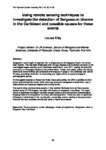Using Remote Sensing Techniques to Investigate the detection of Sargassum Blooms in the Caribbean and Possible Causes for these Events
| dc.contributor.author | Eley, L. | |
| dc.date.accessioned | 2021-12-24T16:54:38Z | |
| dc.date.available | 2021-12-24T16:54:38Z | |
| dc.date.issued | 2021 | |
| dc.identifier.citation |
Eley, L. (2021) 'Using Remote Sensing Techniques to Investigate the detection of Sargassum Blooms in the Caribbean and Possible Causes for these Events', The Plymouth Student Scientist, 14(2), pp. 67-90. | en_US |
| dc.identifier.uri | http://hdl.handle.net/10026.1/18498 | |
| dc.description.abstract |
Sargassum was thought to originate from a single source, the Sargasso Sea in the central west Atlantic. This has been challenged over the past decade after excessive amounts of the macroalgae began washing up on Caribbean coastlines in June 2011, leading the scientific community to investigate causes of this phenomenon. These, now yearly, events are having detrimental environmental and socioeconomic impacts in areas of the Caribbean and central America, providing motivation for uncovering any regime shifts or severe changes in anthropogenic activity. Anthropogenic sources of nitrate from three rivers surrounding the CWA in addition to wind stress and chlorophyll-a levels within the study area are investigated to determine if any of these drivers are stand-out reasons and to what extent. The results show some extreme events of river nutrient discharge from all three sources backed up by MERIS imagery that align with reports of sargassum strandings. The report found no significant correlation between excess nutrients and chlorophyll-a concentrations implying there is no competition for nitrate with phytoplankton. There was also no significant difference in wind stress in the months prior to stranding events, leading to the assumption nitrate is the most probable contributing factor to these occurrences. | en_US |
| dc.language.iso | en | en_US |
| dc.publisher | University of Plymouth | en_US |
| dc.rights | Attribution 3.0 United States | * |
| dc.rights.uri | http://creativecommons.org/licenses/by/3.0/us/ | * |
| dc.subject | Remote sensing, | en_US |
| dc.subject | nutrient discharge | en_US |
| dc.subject | nitrate | en_US |
| dc.subject | phytoplankton | en_US |
| dc.subject | Sargassum, | en_US |
| dc.subject | blooms | en_US |
| dc.subject | Sargasso Sea | en_US |
| dc.subject | Caribbean | en_US |
| dc.title | Using Remote Sensing Techniques to Investigate the detection of Sargassum Blooms in the Caribbean and Possible Causes for these Events | en_US |
| dc.type | Article | en_US |
| plymouth.issue | 2 | |
| plymouth.volume | 14 | |
| plymouth.journal | The Plymouth Student Scientist |



